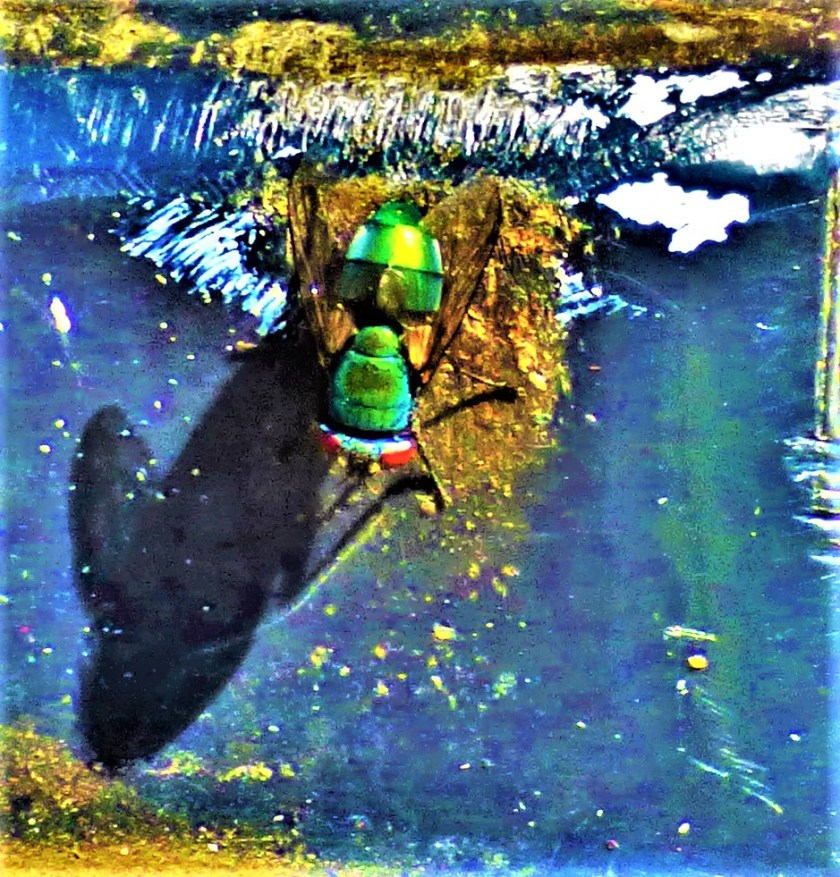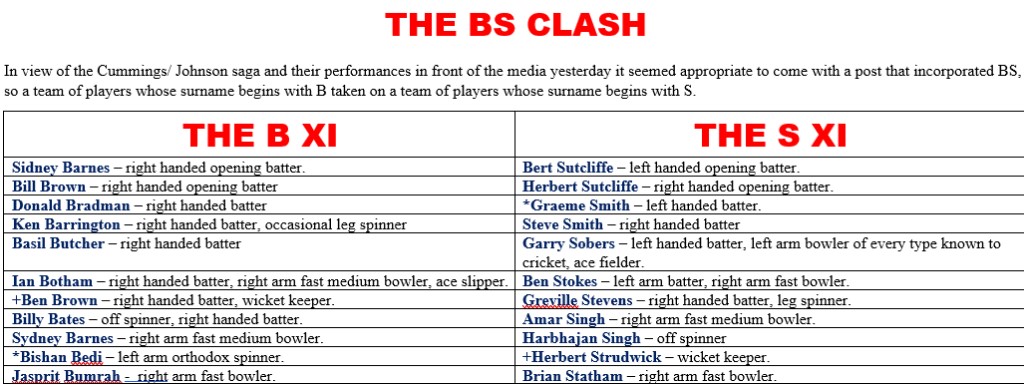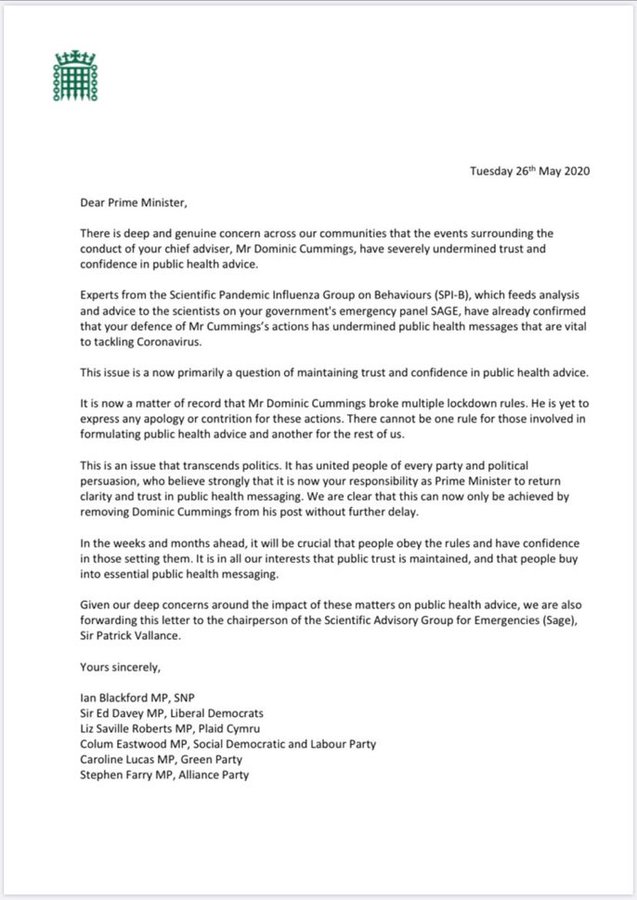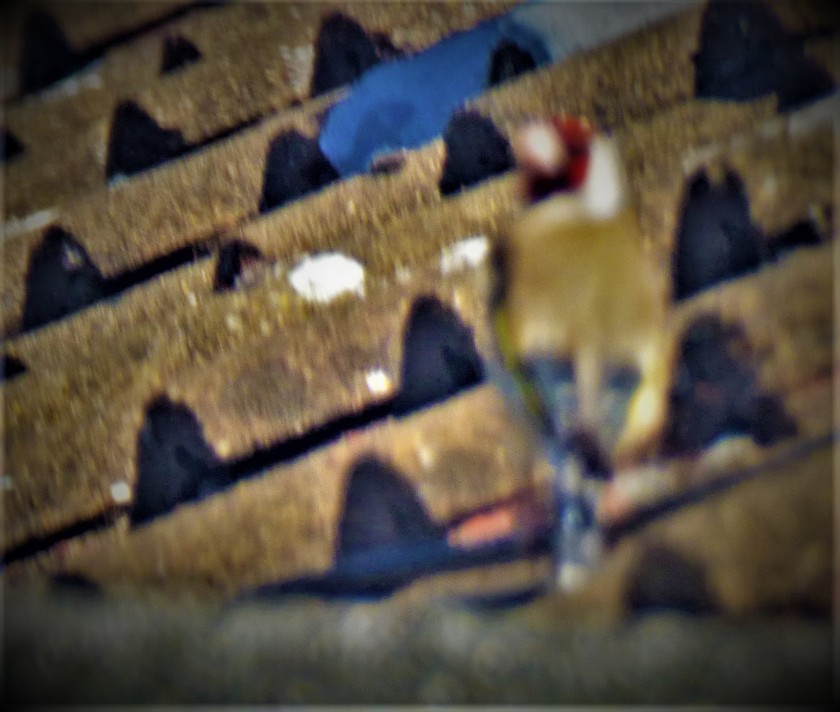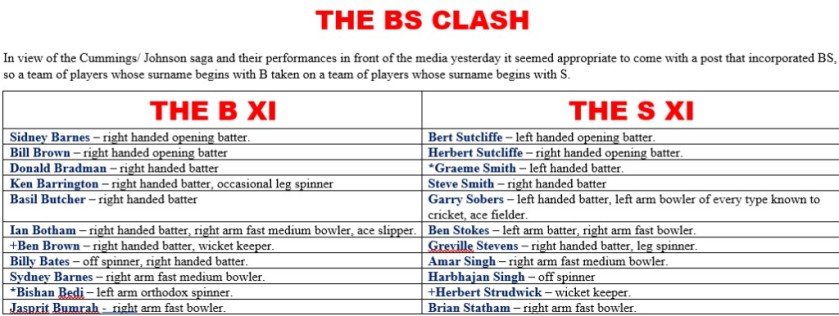INTRODUCTION
Today’s variation on the all-time XI maintains the link with the scandal convulsing British politics at the moment, as a team of cricket’s more prominent good people, named in honour of New Zealand Prime Minister Jacinda Ardern takes on a team drawn from the dark side of cricket, which as punishment for their collective misdeeds bears the name of the 21st century Rasputin.
THE CUMMINGS XI
- David Warner – left handed opening batter. One of the two members of the sandpaper trio to be included in this team (the third of this particular unholy trinity, Cameron Bancroft, is not a good enough player to merit selection, so must make do with this dishonourable mention). He was prepared to appeal against his punishment, so lacking in genuine repentance was he, but when both of his two partners in crime held their hands up even he recognized the hopelessness of his position.
- Salman Butt – right handed opening batter. Captain of Pakistan at the time of the 2010 spot fixing scandal, and one of those in the pay of illegal bookmakers (during the previous Australian season, when I was in that country, he was involved in some odd happenings that in view of his later fall from grace look highly suspicious, such). His two partners in crime, the bowlers Mohammad Asif and Mohammad Amir miss out on places, as he serves for all three (Amir at least pleaded guilty at the first opportunity and accepted his punishment, and is now back playing, whereas the other two both failed to show repentance).
- Mohammad Yousuf – right handed batter. He was captain of Pakistan when they took Australia on at Sydney in 2010. Australia sank for 124 in the first innings, Pakistan led by 200 on first dig, and Australia at the end of the third day were 274-8 in their second innings, Huseey an unconvincing 79 not out and Siddle new to the crease. The following morning Yousuf failed to attack either Hussey or Siddle, and they batted through to lunch without either of their wickets being threatened. As a result of this, instead of having under 100 to chase, Pakistan ended up needing 176, and with Yousuf compounding his felonies by getting out to a dreadful shot to make the score 57-4 they ended up losing. The subsequent abrupt end to Yousuf’s international career suggests that his failings that allowed Australia back into that match had more about them than met the eye.
- *Hansie Cronje – right handed batter, occasional medium pace bowler, captain, criminal and hypocrite. Not only did this man not merely accept but solicit money from illegal bookies, he drew at least two of his most vulnerable team mates (Herschelle Gibbs and Henry Williams) into his web of corruption. When there was no longer any way of denying his guilt he finally confessed, and was banned from cricket for life. Subsequently he died in a flying accident, and some of his compatriots have made attempts to rehabilitate his reputation, but no one outside South Africa is buying it.
- *Steve Smith – right handed batter, occasional leg spinner, captain. The captain of the sandpaper trio, and very lucky indeed as such not to have been banned for life.
- Shahid Afridi – right handed batter, leg spinner. HIs various misdeeds include an incident in which he was caught on camera biting the ball.
- +Kamran Akmal – right handed batter, wicket keeper. He was regarded as a fine batter, but an unreliable wicket keeper, until it emerged that not all of his droped catches had been accidental, and his international career came to a very sudden end.
- Roy Gilchrist – right arm fast bowler. His indelible entry in the hall of shame came in a Central Lancashire League game between Crompton and Radcliffe. Marsh of Radclifffe had been involved as fielder in an incident that aroused Gilchrist’s ire, and when Marsh walked out to open the Radcliffe batting, Gilchrist opening the bowling began with a bouncer, followed by a beamer, and then completed his little performance by charging through the bowling crease and hurling the thing at Marsh from about 16 yards. At that point Marsh and his partner took matters into their own hands and walked off. Both Crompton and Gilchrist copped severe punishments.
- Sylvester Clarke – right arm fast bowler. There were no major incidents like the Gilchrist one above, just a pattern of vicious aggression as a bowler that saw him established as comfortably the most disliked county pace bowler of the 1980s.
- Leslie Hylton – right arm fast bowler. The only test cricket ever to be hanged for murder (just for the record I am deeply opposed to the death penalty). His victim was his wife Lurlene who had been having an affair with a notorious lothario and wanted to leave him. There were those who reckoned that Hylton killed the lothario he would probably have been acquitted, suchwas the man’s reputation. As it was he shot his wife, and came with a defence that has hints of ‘Classic Dom’ about it – he claimed he had been trying to shoot himself rather than her. Among the holes in this were problems with just how anyone could be that inaccurate, and the fact that some point in proceedings he had reloaded the gun. The jury took 40 minutes to arrive at their guilty verdict.
- Jack Crossland – right arm fast. The Lancashire quick was such a chucker that England always refused to select him for that very reason. He was eventually no-balled out of the game.
This team lacks a bit of balance with four fast bowlers and only Afridi as genuine spin option, but otherwise it is perfectly functional.
THE ARDERN XI
- Jack Hobbs – right handed opening batter, occasional right arm medium. A great cricketer and by all reports a fine human being as well.
- Victor Trumper – right handed opening batter. There are countless stories of his goodness. Once on a tour of England Trumper spotted an urchin selling sheet music on the street on a cold wet evening, bought his entire stock, and soon as he was out of sight, binned it. On another occasion a wannabe batmaker asked Trumper to use his product, a misshapen club at least a pound heavier than Trumper’s preferred bats. Trumper used it, scored 80-odd, and returned signed and with a hearty endorsement to the young hopeful.
- *Frank Worrell – right handed batter, left arm medium fast bowler, occasional left arm spinner, captain. In the words of CLR James “He was a happy man, a good man and a great man.”
- Sachin Tendulkar – right handed batter. In the 1996 World Cup, when he could have secured sponsorships from absolutely everybody he made a point of refusing to accept money from purveyors of booze or cigarettes. Subsequently he has used the great wealth he acquired from cricket to assist the less well off in his native Mumbai.
- Ellyse Perry – right handed batter, right arm fast medium bowler. She is regarded pretty much as highly for how she conducts her life as for how she plays the game.
- Learie Constantine – right handed batter, right arm fast bowler. CLR James again “He revolted against the revolting contrast between his first class status as a cricketer and his third class status as a human being”. His civil and human rights work after his cricket days were done earned him a knighthood and ultimately the title of Baron Constantine of Maraval and Nelson.
- +Sarah Taylor – right handed batter, wicket keeper. Her bravery in speaking out about her own mental health issues and encouraging others to do likewise gets her in here.
- Tom Cartwright – right arm medium fast bowler, useful lower order batter. He actually began his career as a batter, before concentrating his attention on bowling. His withdrawal from the 1968-9 tour party to South Africa virtually obliged the MCC to name Basil D’Oliveira as his replacement, which forced Balthazar Johannes Vorster, the racist thug who ran South Africa at the time, to tip his hand. Vorster stated publicly what he had already privately told certain English high-ups, that D’Oliveira would not be accepted, and that was the end of the tour, and the beginning of the process that led to South Africa’s sporting isolation, and contributed to the downfall of Apartheid. Various people tried various underhanded methods to get apartheid South Africa back into the international fold, but it took the release of Nelson Mandela and subsequent dismantling of apartheid to end their isolation.
- Hedley Verity – left arm orthodox spinner. Captain Verity of the Green Howards was leading his men towards a strategically important farmhouse on the island of Sicily in 1943 when he was hit by a shell. His last words were “Keep going, keep going”.
- Radha Yadav – left arm orthodox spinner. 49 international wickets, all in T20s, at 16 each, and she has only just turned 20, and is clearly still improving. When she got her central contract to play for the Indian Women the first thing she did with the money that came with it was buy a proper shop for her father, who had earned a small living as a street vendor.
- Glenn McGrath – right arm fast medium bowler. A good few English batters of the 1990s and early 2000s will wonder how he can qualify for this team, but his work with the Jane McGrath foundation, which he established in honour of his first wife who died of breast cancer at the age of just 42 gets him in.
This team has a good batting line up, and a well varied bowling line up. Although Verity and Radha Yadav both bowl left arm spin Verity was quicker than most bowlers of that type, and except on rain affected pitches not a huge turner – variations of flight and pace were his main weapons.
HONOURABLE AND
DISHONOURABLE MENTIONS
Everyone will have their own ideas about inclusions and exclusions from these squads. Conrad Hunte might had an opening berth in the Ardern XI but for me he cannot quite dislodge Hobbs or Trumper. Mohammad Azharruddin and Saleem Malik were probably the most prominent batters to escape the Cummings XI, while Charlie Griffith and Colin Croft might have had places as fast bowlers. Obviously there have been spinners with dodgy bowling actions, but the worst offender, Tony Lock, was genuinely horrified when he saw video footage of his own bowling on the 1958-9 tour and promptly remodelled his action, going on to bowl with distinction for Leicestershire and Western Australia. Most of the stories that exist of spinners misdemeanours do not suggest true villainy. Also just for clarification I do not regard ‘Mankadding’ as in any way an offence – if you seek to gain advantage by leaving your ground at the non-strikers end early and the bowler runs you out, well don to them, so I never even considered Vinoo Mankad. Finally, there have been plenty of wicket keepers whose over-enthusiasm for appealing has led to dodgy incidents, but I am disinclined to be over harsh on that sort of thing.
THE CONTEST
I think that the Ardern XI would see justice done by winning this one – especially if the groundstaff were discreetly advised to prepare turners for Hedley Verity and Radha Yadav to exploit. Given some of the players in the Cummings XI, I suggest Dickie Bird and Frank Chester as on field umpires, Aleem Dar as TV Replay umpire, Clive Lloyd as match referee.
ON THE SCANDAL
At the most recent count that I have seen, which dates from last night, has almost certainly increased since then the number of Tory MPs to have publicly stated that Cummings needs to go has gone into the forties:

Shrewd observers will note that the name of Northwest Norfolk MP James Wild is not on that list. I have as yet have no response to my email to my him on Monday (automated ones do not count), and this morning I got on to him again:
Thomas Sutcliffe
21 Columbia Way
King’s Lynn
Norfolk
PE30 2LA
Email: thomasavsutcliffe@gmail.com
Wednesday 27 May 2020
Dear James Wild,
I wrote you on Monday morning about the Dominic Cummings scandal. So far other than the automated acknowledgement one always gets for such things I have yet to receive a response from you. Meanwhile the scandal has deepened and extended to become the Cummings/ Johnson scandal. Cummings’ public appearance in the rose garden at Downing Street exacerbated an already bad situation as he failed to show any remorse for his conduct or any understanding of why people were angry, and the story he hold in a pathetic attempt to justify his conduct had more holes in it than my colander. Then came Johnson’s follow up in which he refused to answer questions about Cummings. Then yesterday there was ‘Hancock’s Half Hour’ which was again marked by the arrogance and lack of understanding that has been the feature of all official Tory responses to the situation.
Cummings’ position is completely untenable, and by supporting him so unequivocally Johnson has put his own position in great jeopardy. Over 40 of your Conservative colleagues have publicly stated that Cummings must go, and one minister at least has resigned in protest at the government’s handling of this situation. It is way past time for you, who used to be one of Johnson’s advisors, to stand up and be counted, and make it clear to Johnson that continuing to ignore the public is entirely unacceptable and that at barest minimum Cummings must be fired (at this stage allowing him to resign would no longer be acceptable).
Many people in tougher situations than that experienced by Cummings managed to adhere to the lockdown in full and without caveats.
While ever Cummings remains in post the government has no moral authority to impose lockdown measures, though I believe that such are still necessary.
Yours sincerely,
Thomas Sutcliffe
A MEASURE OF MATHEMATICS
I have a solution and another problem for you. In yesterday’s piece I included the following:

There are only to ways to split eight tiles such that each of three people have different numbers of tiles and all eight are used: 4,3,1 and 5,2,1. 11 cannot be reached with one tile, so Kaitlin has at least two tiles, but she has also said that she does not have the greatest number, so she has no more than three. Kaitlin’s tiles have sum 11 and a product divisible by three, which means that they must include either the six or the three. A little bit of experimenting leads to the conclusion that the only way to meet all the criteria is if Kaitlin had 6,4 and 1, Kevin just has the 8 and Conor the remaining four tiles, 2,3,5 and 7. We are looking for the sum of Conor’s tiles and that comes to 17.
Today’s problem is this:
Solution as usual in a later blog post.
PHOTOGRAPHS
My usual sign off…



